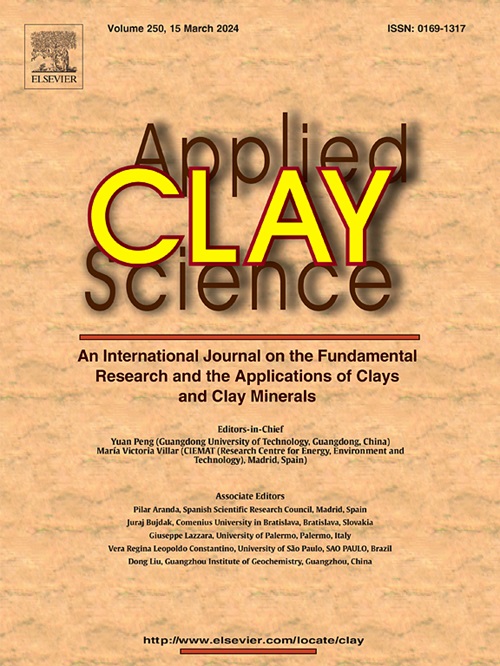An acid-free short-flow process for high-quality separation of kaolinite in coal waste rock: Based on mineralogical determinations
IF 5.3
2区 地球科学
Q2 CHEMISTRY, PHYSICAL
引用次数: 0
Abstract
Coal waste rock (coal gangue), as a traditional industrial solid waste, is of great significance to resource recycling and environmental pollution reduction through scientific planning and classification separation. Herein, an acid-free short-flow process for purifying kaolinite from coal gangue was innovatively proposed based on the analysis of the mineral composition. The fine-grained pyrite in the coal gangue was transformed into hematite (Fe2O3) through the pretreatment of low-temperature air roasting, creating enhanced conditions for magnetic separation. Thermodynamic calculations showed that hematite can be stabilized as an independent phase in the kaolinite system, reducing the loss of kaolinite in the separation process. The effects of single-factor tests such as roasting temperature, magnetic separation conditions, grinding fineness, and whitening agent dosage on the purified samples were studied. Under the optimal conditions, a purified product with a yield of 90.28 %, a SiO2 content of 50.09 %, an Al2O3 content of 45.41 %, a Fe2O3 content of 0.34 %, a TiO2 content of 1.34 %, and a whiteness of 88.71 % could be obtained. Economical estimates suggested that the revenue from process operation is approximately 538.34 CNY/t (73.07 $/t). This simple and easy-to-operate process flow provides new insights into the classification and utilization of coal gangue.

煤废岩中高岭石高质量分离的无酸短流工艺:基于矿物学测定
煤矸石(煤矸石)作为一种传统的工业固体废弃物,通过科学的规划和分类分选,对资源循环利用和减少环境污染具有重要意义。在分析煤矸石矿物组成的基础上,创新性地提出了一种从煤矸石中提纯高岭石的无酸短流工艺。煤矸石中的细粒黄铁矿经低温空气焙烧预处理转化为赤铁矿(Fe2O3),为磁选创造了有利条件。热力学计算表明,赤铁矿在高岭石体系中可以作为独立相稳定存在,减少了高岭石在分离过程中的损失。研究了焙烧温度、磁选条件、磨矿细度、增白剂用量等单因素试验对纯化样品的影响。在此条件下,可获得产率为90.28%、SiO2含量为50.09%、Al2O3含量为45.41%、Fe2O3含量为0.34%、TiO2含量为1.34%、白度为88.71%的纯化产物。经济估算表明,工艺操作的收入约为538.34元/吨(73.07美元/吨)。这种简单易操作的工艺流程为煤矸石的分类和利用提供了新的见解。
本文章由计算机程序翻译,如有差异,请以英文原文为准。
求助全文
约1分钟内获得全文
求助全文
来源期刊

Applied Clay Science
地学-矿物学
CiteScore
10.30
自引率
10.70%
发文量
289
审稿时长
39 days
期刊介绍:
Applied Clay Science aims to be an international journal attracting high quality scientific papers on clays and clay minerals, including research papers, reviews, and technical notes. The journal covers typical subjects of Fundamental and Applied Clay Science such as:
• Synthesis and purification
• Structural, crystallographic and mineralogical properties of clays and clay minerals
• Thermal properties of clays and clay minerals
• Physico-chemical properties including i) surface and interface properties; ii) thermodynamic properties; iii) mechanical properties
• Interaction with water, with polar and apolar molecules
• Colloidal properties and rheology
• Adsorption, Intercalation, Ionic exchange
• Genesis and deposits of clay minerals
• Geology and geochemistry of clays
• Modification of clays and clay minerals properties by thermal and physical treatments
• Modification by chemical treatments with organic and inorganic molecules(organoclays, pillared clays)
• Modification by biological microorganisms. etc...
 求助内容:
求助内容: 应助结果提醒方式:
应助结果提醒方式:


